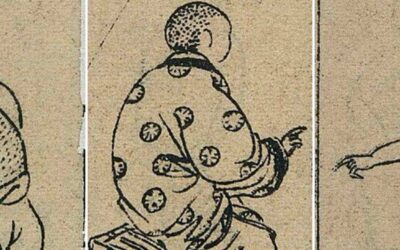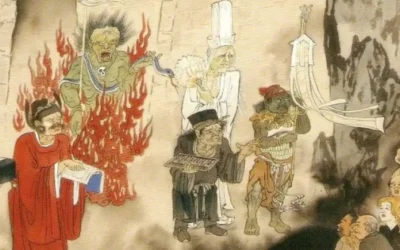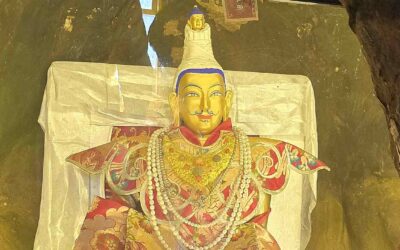David Holm.- Recalling Lost souls: The Baeu Rodo Scriptures – Tai Cosmogonic Texts from Guangxi in Southern China. Bangkok, 2004. 344 pp.
This is one of the most valuable books to know the myths and culture of the Zhuang. After an introduction to Zhuang culture and way of life, it contains the translation of 12 important myths of the Zhuang. These myths were preserved in the Zhuang scriptures, religious books used for their bimos to perform some ceremonies and rituals. In order to let the reader have a accurate idea of the content and value of this book we publish here three short fragments. The first is the part of the “Introduction”, the second is the “Table of contents”, and the third is an interesting fragment of the myth of the creation of water buffaloes.
- Introduction
Some twenty or thirty years ago, Chinese scholars investigating remote villages in the western highlands of Guangxi province began to report the existence of remarkable collections of Zhuang ritual manuscripts. Written in the old Zhuang script, a variant of the Chinese character script, these manuscripts gave every indication of being of venerable age. The scriptures themselves were cast in an archaic form of five-syllable verse, and in content appeared to be connected with Baeu Rodo and Mo Loekgyap, the apical ancestors of the Zhuang, Baeu Rodo, whose name is sometimes said to mean the old man who knew everything, was a well-known trickster figure in Zhuang folklore, while Mo Loekgyap, at least in some areas, was known as a mother-goddess figure with an enormous vulva.
These were exciting discoveries, as they seemed to reflect the very earliest stages in the formation of Zhuang culture. Many of the scriptures were cosmogonic that is, they presented a mythic account of the origins of the world: of heaven and earth, of humankind, of rice, and of domestic animals and fowls. At the same time, they recounted how the earliest ancestors of the Zhuang, acting on the advice of Bacu Rodo and Mo Loekgyap, had established human institutions such as writing, chieftaincy, and family relations, and religious practices such as offerings, sacrifices, and the summoning of lost souls.
It is small wonder that scholars began to collect such scriptures more systematically almost from the beginning of the Reform Period in 1979. The scriptures included in the present volume result from those efforts, and come from a tradition which may indeed incorporate very ancient material. Many direct parallels will be found here with the myths and legends of Tai peoples elsewhere in mainland Southeast Asia, and scholars with an interest in the religious traditions of the ancient Tai will find much to interest them. This collection shows too that the Zhuang, like Tai-speakers elsewhere, are a highly adaptable people who have been able and willing to borrow ideas and terminology from their neighbours. While in mainland Southeast Asia the Thai have adopted Pali and Sanskrit to provide the language of organised religion and the elevated language of the state, for the Zhuang and other Tai groups in the south of China it is Chinese that has served as the primary vehicle for Buddhist and Taoist teachings, and furnished the bureaucratic and cosmological trappings of native chieftaincies. In their cultural dexterity, however, Tai peoples
everywhere share a common trait.
- Fragment from Recitation for Redemption of Souls of Water Buffalo and Horses (p. 176)
King Shun was all-knowing,
Pan and Gu were all-creative.
They Created the ox by the side of the pond,
They took two horns and stuck them on facing forward.
They Created the water buffalo by the side of the river,
They took two horns and stuck them on facing backward.
They Created the goat at the foot of the wall,
Its tail was on a level with the knee-caps.
They Created the water buffalo in a place with fine downy grass,
They heaped up a water buffalo in a place where animals rolled
They used waterlogged wood for its legs,
They used yanmin fruits for its teats.
They used hardwood trees for its bones,
They used the leaves of the wild plantain for its intestines.
They used a whetstone for its liver,
They used red earth for its flesh,
They used hornets’ nests for its stomach.
They used river rocks for its hooves,
They used the pointed end of a dagger for its horns.
They took it and buried it in a place with fine soft grass,
They took it and heaped up earth around it in a hollow.
They used a liquidambar leaf for its tongue,
They used big floppy leaves for its ears…
- Table of Contents
List of Illustrations
Preface
Note on Transcription and Transliteration
Abbreviations
The Companion CD
INTRODUCTION
The Zhuang
The Locality
Religious Life of the Northern Zhuang Baeu Rodo and Mo Loekgyap
The Boumo and their Rituals
Poetics and Versification in Boumo Scriptures
The Language of the Scriptures
The Old Zhuang Script
Discovery and Decipherment
Conventions Used in this Book
Notes
THE TEXTS
Text 1. Ritual of Prayer before the Domestic Altar
Text 2. Scripture on the Creation of Heaven and Earth
Text 3. Recitation on the Search for Water
Text 4. Recitation on the Creation of Fire
Text 5. Scripture on the Redemption of the Rice Spirit
Text 6. Recitation for the Redemption of the Souls of Water Buffalo, Oxen and Horses
Text 7. Scripture on the Redemption of the Souls of Swine
Text 8. Recitation for the Redemption of the Souls of Ducks and Chickens
Text 9. Recitation for the Redemption of the Souls of Fish
Text 10. Scripture Reciting the Creation of Houses, Gardens and Fish-nets
Text 11. Scripture Reciting the Creation of Native Chieftains and Emperors
Text 12. Scripture Reciting the Creation of Books and Writing
Appendix
Bibliography
Index
Last posts
The Smallpox Goddess (Doushen)
The Smallpox Goddess (Doushen) The Smallpox Goddess (Doushen 痘神) is part of a group of goddesses whose primary role was the protection of children. In the final years of the imperial era, they operated under the authority of Bixia Yuanjun, the daughter of the Emperor...
The Solution to the West’s Suicide Epidemic Can Be Found in the Culture of a Himalayan People
The Solution to the West’s Suicide Epidemic Can Be Found in the Culture of a Himalayan People In recent years, the number of suicides among young people has skyrocketed. In some countries, such as Spain, suicides have already surpassed traffic accidents as the leading...
Drak Yerpa: The Tibetan Cliffs of Meditation
Drak Yerpa: The Tibetan Cliffs of Meditation A visit to the cliffs of Drak Yerpa, about 30 kilometers from Lhasa, not only offers a glimpse of the beauty of the Tibetan landscape and some rural settlements near the capital, but also gives us the chance to explore one...







